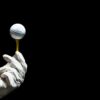The Early Days of Golf Equipment: The Hickory Era
It’s easy, when browsing used sets of clubs and vintage golf equipment, to dismiss the dusty all-wood ones as being way too old. After all, who would want to play with those kind of sticks when there are so many cool-looking metal and graphite clubs available today? Old traditional golf clubs seem more of a novelty now, perhaps something you’d find in a grandparent’s dusty garage and worry that they’d snap if you hit the ball too hard.
You might be surprised, however, to learn that the wooden ones, particularly hickory golf clubs, were the standard in not just the U.S. but the world for hundreds of years. And plenty of players played just fine with this early golf equipment.
Hickory golf clubs are actually considered relatively new, at least when looking at the total timeline of golf: they started showing up in the late 18th century, an improvement on the simple all-wood clubs that were in use since the 1300s.
Early golf equipment was really more ‘caveman’-style clubs more suited for smashing, rather than the streamlined, customized clubs on the market today. Historically, clubs were made out of everything from persimmon to pear tree branches.
Metal clubs, or at least wooden clubs with iron heads, didn’t start showing up until the late 19th century, but even then were inconsistent and heavy. Handcrafted hickory clubs have a reputation as being durable, they also have their limits.
To play well with hickory clubs, you need a firm, steady strike but also a slower swing overall.
The Transition to Steel: A Game-Changer in Golf Clubs
Experimentation in metal materials at the end of the 19th century and beginning of the 20th century eventually led to the appearance of steel golf clubs. Steel shafts as well as steel clubs provided plenty of power to players as well as more accuracy and durability, when compared to hickory.
Steel golf clubs were officially approved by The Royal and Ancient Golf Club of St. Andrews, golf’s governing body, in 1929, when the Prince of Wales used a set at St. Andrews.
Research continued into overall golf club innovation, including a push for lighter material that still provided power. Around the 1960s, golf equipment advances began to yield the use of synthetic materials. This lowered the overall price of clubs and also helped people hit further, two great benefits.
Taylor-Made was one of the companies that focused on making modern golf clubs that had steel heads instead of wood heads. Callaway also attracted attention when it released the Big Bertha, a driver with a stainless steel head and graphite shaft that provided great power.
Once players tried – or at least heard about – these sleek new club materials, it wasn’t hard to embrace them and move away from the classic hickory/all-wood woods.
The Impact of Graphite: Lightweight and High Performance
Graphite golf clubs became available starting in the early 1970. While manufacturers continued to try and develop the perfect head, be it steel, wood, or hybrid/metalwood, efforts also were made to create a more durable yet lightweight shaft.
High-performance golf clubs moved away from steel to something lighter and more flexible that can benefit overall performance. Graphite shafts were lightweight yet flexible. They could absorb a good hard drive, and players don’t have to worry about breaking a wood club and also is more forgiving than a steel club.
The Big Bertha, released in 1991, was a perfect example of this type of lightweight golf equipment – not only did it have a powerful head but a graphite shaft. Graphite golf clubs also made the game more accessible for all ages and physical abilities, including seniors who may not have the strength anymore to use the heavy irons.
By the early 2000s, graphite material in the shafts was common in a variety of clubs, not just the big drivers. Golf technology made materials easier to use overall. Longtime players could still use their bag full of irons and woods and play just fine but golf technology and modern golf innovations also made it just as easy to play well using lighter clubs.
Golf Balls: From Feathers to Multi-Layered Technology
While innovations and experimentation in club design and materials get plenty of attention, there has also been some serious evolution of golf balls.
Golf ball technology has also improved but at a slower pace, but there have been significant upgrades and improvements over the centuries to the high-tech golf balls we use today.
Previous to the early 1600s, balls were believed to be either stuffed with animal hair or made out of wood. But in 1618, the official “featherie” ball was announced at St. Andrews. It was a leather pouch stuffed with chicken or goose feathers. The feathery golf balls were light, traveled far when hit, and not hard to create. They weren’t necessarily durable – a hard hit could break them, and they were also susceptible to water damage.
These became the standard until the late 1890s when balls filled with sap were introduced, followed by a core of rubber bands or rubber material. Research continues into optimal core materials for modern golf balls, including glycerin and small amounts of metal, but some types of rubber does seem to be standard in multi-layer golf balls.
High-Tech Innovations: GPS, Rangefinders, and Wearables
Players seeking better performance have access to more golf technology beyond their clubs and ball. There are all sorts of high-tech golf equipment for your golf bag and elsewhere that can enhance your game and lower your score.
This includes golf GPS devices that help you better visualize the lay of a hole; golf rangefinders, which provide info about elevation, yardage, and course features; and golf wearables, which are items like glasses or watches that also provide detail about the hole, including measurements to the pin, hazards to watch out for, doglegs to plan a strategy for, and even what club you should use.
These modern golf gadgets are certainly useful tools that can improve the game by helping you research each hole. But ultimately, you still need to swing well consistently.
Custom Fitting: Personalized Golf Equipment for Optimal Performance
Custom golf technology has evolved so players not only have a lot of choices in the materials in their clubs and balls, but their clubs can also be designed especially for their grip and swing. Custom golf fitting can help players achieve optimal golf performance by using clubs created just for them. Even though experienced players can probably do fine with any club, using personalized golf clubs and similar tailored golf equipment may help them feel more comfortable with their clubs.
Custom fitting goes beyond grip, stance, and swing: it analyzes all sorts of factors like height, weight, and body type. It looks at how you swing, including any common problems like slicing in certain directions. Then, the professional doing the fitting can create custom clubs that have the potential for you to hit more accurately more often and have your ball go further if you’re hitting it more consistently.
The Future of Golf Equipment: What’s Next in Golf Technology?
People have been playing golf since the 1400s. But there’s always effort to make the game more interesting and improve how people play. The 20th and even parts of the 21st century alone include all sorts of advances in the design of clubs, balls, and other tools.
This creates the natural question about what future golf equipment will help our games? What innovative golf gear can improve our distance and make the game fun?
Certainly there is interest in accessibility: serious golfers want to play as much as possible, so ways to make the clubs lighter are a plus. They also want to have satisfying games, so accuracy is also welcome.
The future of golf will likely include more ways to interact with the Internet, such as apps that provide info about the course, the holes, the clubs, and the weather. This may be done via mobile phones or even next-gen golf technology that syncs info in carts or at the tee box for each hole. Emerging golf trends will also include more wearables to measure even more of your game.
People who follow equipment predictions expect more options for carbon fiber-based clubs that are lightweight yet powerful. Some club manufacturers are also offering options for golfers who want to mix and match their club sets, such as changing a head or a shaft.








Add comment
You must be logged in to post a comment.